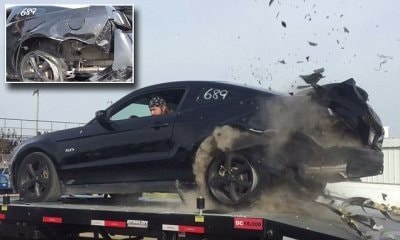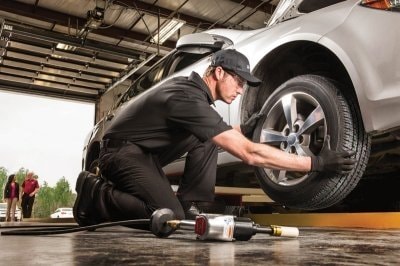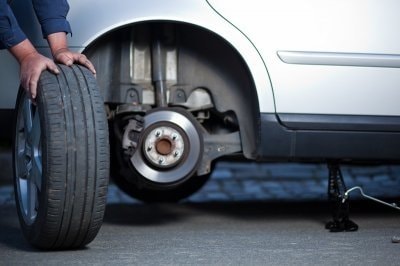Causes and how to handle car tire blowout
Overloaded cars, potholes, under-inflated or too old tires are the main causes of tire blowouts.
1. Causes of car tire explosion
Car tires are underinflated.
Under-inflated car tires are considered the main cause of tire explosions. In fact, according to the operating principle of the car, the air pressure in the car tire is responsible for supporting the entire weight of the car as well as the weight of passengers and luggage. Under-inflated tires mean that the tire has to take on more "responsibilities", causing the tire components including: steel wire, rubber, tire tread and tire bead to work too hard. In addition, under-inflated tires will not cool the tire, plus the friction area between the tire and the road surface will cause overheating and easy explosion.
Experienced drivers say you should regularly check your tires with a handheld tire pressure gauge or install a tire pressure sensor for continuous monitoring. When pumping your tires, you must also ensure that you follow the pressure specifications, which are usually posted on the back of the driver's door.
Overloaded vehicles
Overloaded trucks have become a perennial "problem" for trucks in Vietnam. Overloading has unintentionally put tires in a state of "maximum load limit". At this time, the heat generated during friction with the road surface and moving over bumpy roads will push the tire's endurance beyond its limit. Therefore, the situation of car tires exploding is inevitable.
Fall into a pothole
 |
| Drivers should drive at a moderate speed if they are unfamiliar with the road. It is difficult to see potholes at a distance when the driver's vision is limited, especially when traveling at high speeds. |
A pothole is something that will "kill" a car tire instantly, and can even destroy the entire rim. If you are driving at low speed, hitting a pothole will only make you feel uncomfortable. However, when driving at high speed, the pressure from the road surface will cause the tire to explode, the rim to crack, and more seriously, the shock absorber to break.
In case you are driving a sports car with large rims, this means that the thickness of the tire wall will be very thin and just hitting small bumps or rocks at high speed is very likely to cause the tire to explode. Therefore, the advice of experienced car driving experts is to drive at a moderate speed if you are not familiar with the road. It is very difficult to recognize potholes at a distance when the driver's vision is limited, especially when moving too fast.
Car tires are too old
Every tire has a tread or tread pattern, the main function of which is to conduct water to improve traction and prevent hydroplaning on wet roads. According to most manufacturers' standards, a tread depth of less than 1.6 mm means the tire is worn and unsafe.
 |
| Car drivers should change tires after 50,000 km and depending on road conditions. |
According to manufacturers' recommendations, drivers should change tires after 50,000 km and depending on road conditions. If you often drive on bad roads, you should change them after 40,000 km or after 5 years of use. If the tires are too old, they will wear to the limit and when operating at high speeds, the factors of temperature, pressure and load will completely destroy your tires.
2. How to handle a car with a flat tire
Just hearing the following 3 sounds can confirm that the car tire has exploded: a very loud bang (due to the tire being destroyed by pressure), a very loud spray (due to air escaping) and the "thump thump" sound of the rubber tire rubbing against the road surface.
In more serious cases, if the tire is completely blown off, you will definitely hear the sound of the rim rubbing against the road. So how should we handle this to avoid losing control or crashing into another vehicle?
 |
| When your car tire blows out, try not to brake, just let go of the accelerator and keep the steering wheel straight. |
When a car tire blows out, the basic reflex of drivers is often to brake or turn the steering wheel in the opposite direction because they notice the car is tilting. However, this action only makes the unbalanced car worse. At this time, try not to brake, just release the accelerator and keep the steering wheel straight because when the car is unbalanced, safety systems such as the ESP electronic balance system and EBD electronic brake force distribution will intervene immediately. If you do more, it will be very difficult for the ECU central controller to handle the situation. Slowly apply the brakes and pull the car to the side of the road when the car is stable.
To handle this problem, the driver must have good steering wheel habits. The correct steering posture is with the left hand at the 9 o'clock position on the steering wheel, the right hand at the 1 or 2 o'clock position. The left thumb always hugs the steering wheel slightly above the fork. When hearing a loud bang or hiss, the driver's first reflex is to hold the steering wheel tightly with the left hand, and the right hand immediately grabs the 3 o'clock position (also on the fork).
If the car is leaning to the right, use your left hand to pull the steering wheel in the opposite direction and push it out with your right hand. If the car is leaning to the left, use your left hand to push it out and use your right hand to pull the steering wheel to the right. Try to keep the car going straight due to inertia, use your feet to slow the car down with moderate force, then slowly bring the car to a stop. Most importantly, do not brake suddenly, because if you do, the car will definitely flip over.
According to VNN
| RELATED NEWS |
|---|

